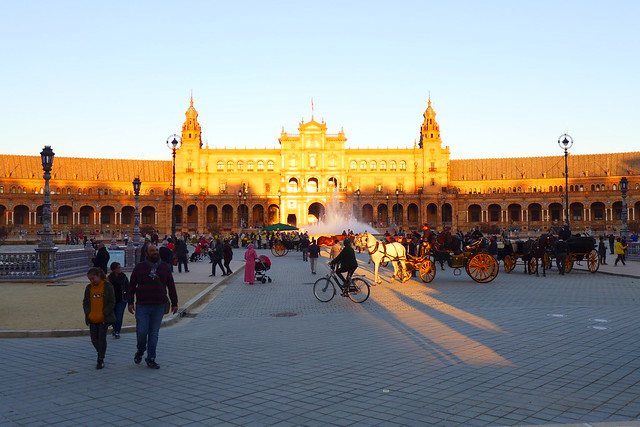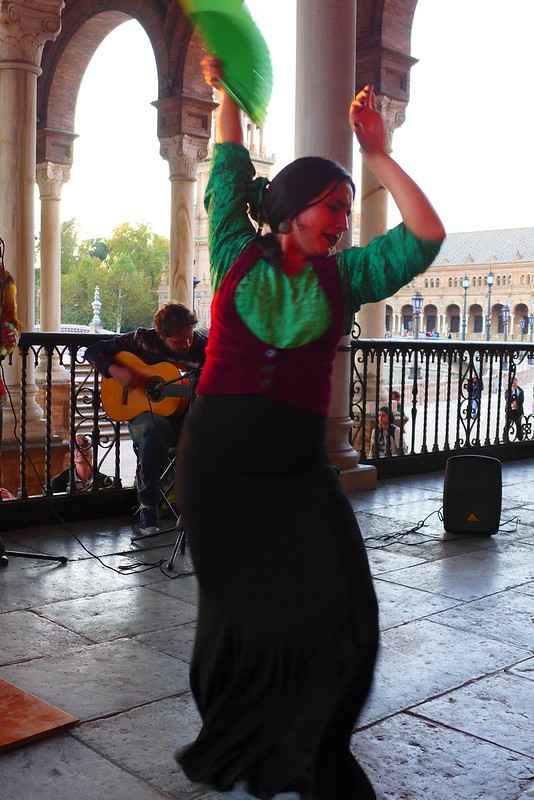Crossing Spain North to South
The next couple of days, we travel along the Ruta de la Plata, through Extremadura all the way down to Sevilla. True to its name, a lot of the landscape seems extremely hard. It’s almost desert-like in some places, but a tired looking desert, as if mankind has sucked all energy out of it. What use is this land anymore to any farmer in this state? Who lives here and tries to eke out a living? I have visions of intrepid individuals taking over valleys and bringing life back to the land by using permaculture, but in fact, to change anything here it would probably need a government decision to reforest a large area, thus changing the climate.
It’s quite meditative driving along this route – not much traffic and the landscape doesn’t change much from the eternal undulating brown, interspersed with a few olive trees.
One evening, I consult my map to stop somewhere by a river for the night. We make a 10km detour to find the river, but it turns out to be a stagnant water, a stench of decay rising from it and large areas are covered in a pinkish algae. We turn around and drive on… We pass a little village where most of the ‘houses’ are doors in a hillside and a chimney sticking out the top.
In stark contrast to the rural poverty, every city we come to along this route is a surprise. Zamora is beautiful. We park up by the municipal sports stadium which boasts an oplympic size swimming pool and after a swim and a sauna, we take off into town on our bike. As in Leòn, we are pleasantly surprised by the vibrancy, the cobbled streets, the nooks and crannies and the variety of shops. People are well dressed and seem to be contented with their lives.
We stop to sleep in Plasencia but don’t spend any time to explore it – we want to conserve our ‘city energy’ for Sevilla. Lunch time next day has us cycling through Mèrida, another interesting looking town, with some roman temple and amphitheatre remains, as well as a beautiful roman bridge stretching a long way over a shallow river basin. Another few hours later we arrive at dusk in Sevilla, securing a parking space in a paid, supervised car park within easy cycling distance of the city centre.
Sevilla is a beautiful city. Spacious, verdant, vibrant. So may beautiful buildings, a large old quarter where you easily can get lost in tiny alleyways, many tapas bars and restaurants ( although we weren’t too impressed by the price or quality of the food – restaurant Rozelaar won out over Sevillan cuisine!!!) Our favourite place is Plaza de la España, beautifully cobbled with different coloured stones, where a fountain, a moat and an incredible crescent-shaped building with vaulted colonnades form the backdrop to fantastic outdoor flamenco singers and dancers. On the second day we speak to them and find out that they are part of a large group of Flamenco students who take it in turns to sing, play and dance with each other every day from 5-8pm five days a week. This is high quality music and dancing and their love for it sparkles from every movement and sound. They have an appreciative seated listening crowd, who donates generously to the hat that passes round at 15 minute intervals, which is more than can be said of the dedicated flamenco bar we visit on one of the evenings, where people talk across the music.
Sevillas Flamenco is different to what we have seen in other parts of Spain – just as the city itself, it is light, smiling, ebullient, celebratory.
We thoroughly enjoy ourselves in Sevilla for three days, but the moment has come to move on when a huge cruise ship anchors opposite us on the river one night, keeping us awake with the low chug-chug of its diesel engines, spewing fumes that make it difficult to breathe after a day. It’s time for a day in a quiet spot, to digest all the impressions we have gathered.
For more photos on travelling soutwards , click here
for photos of Sevilla, click here
Posted in Uncategorizedwith comments disabled.

